1. Create applet and select cloud development
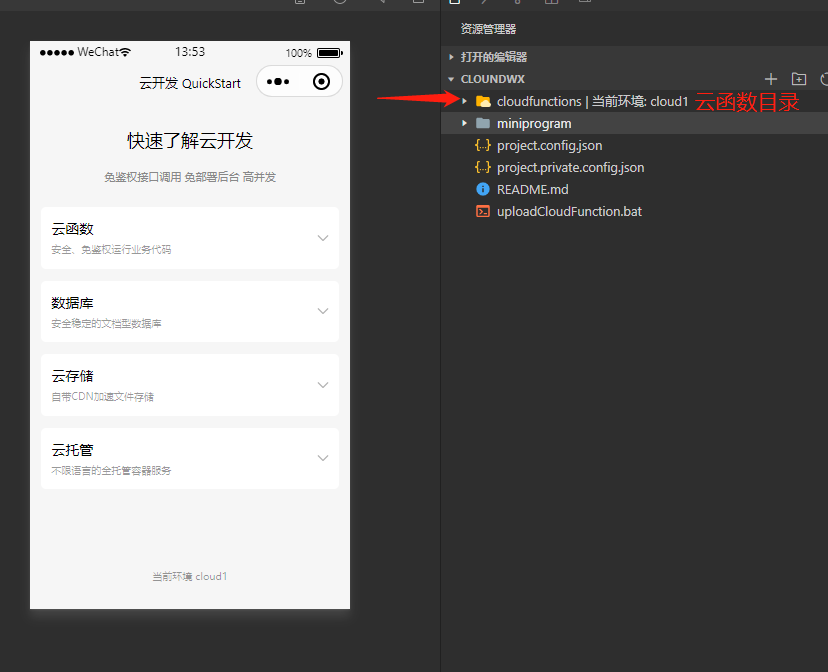
Corresponding environment
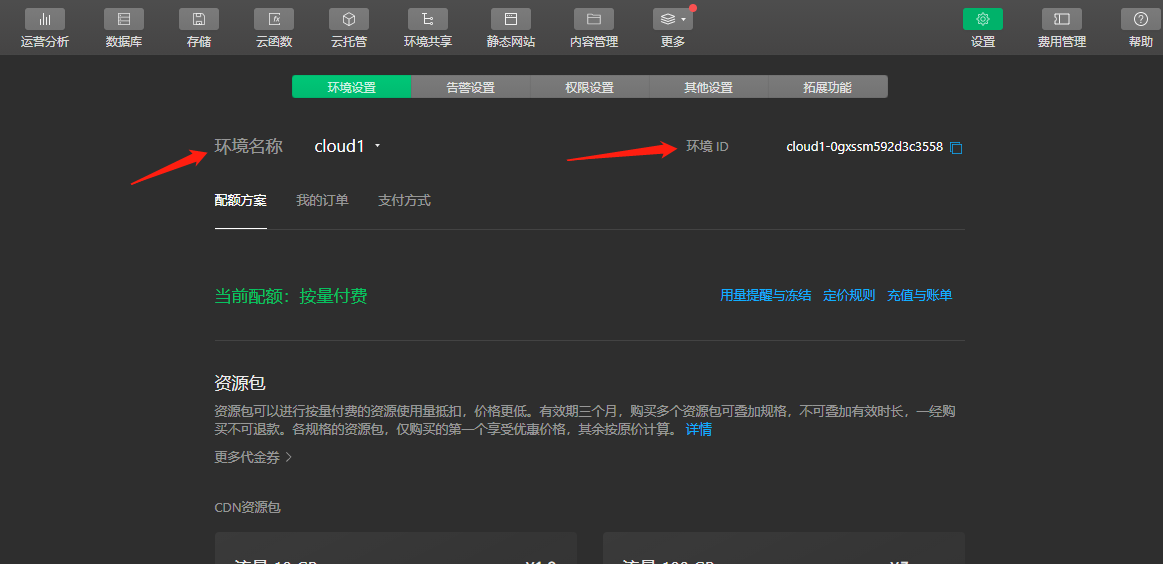
On app Configure environment Id in JS
//app.js
App({
onLaunch: function () {
if (!wx.cloud) {
console.error('Please use 2.2.3 Or above to use cloud capabilities')
} else {
wx.cloud.init({
// env Parameter Description:
// The env parameter determines which cloud environment resources will be requested by default for the next cloud development call (wx.cloud.xxx) initiated by the applet
// Please fill in the environment ID here. You can open the cloud console to view the environment ID
// If it is not filled in, the default environment (the first created environment) will be used
env: 'cloud1-0gxssm592d3c3558',
traceUser: true,
})
}
this.globalData = {}
}
})
Get cloud function of openId
const cloud = require('wx-server-sdk')
cloud.init({
env: cloud.DYNAMIC_CURRENT_ENV
})
// Get openId cloud function entry function
exports.main = async (event, context) => {
// Get basic information
const wxContext = cloud.getWXContext()
return {
openid: wxContext.OPENID,
appid: wxContext.APPID,
unionid: wxContext.UNIONID,
}
}
project. The config file defines the cloud function and the file name of the project directory, which are modified together when modifying
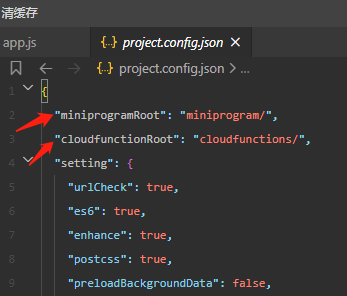
2. Database
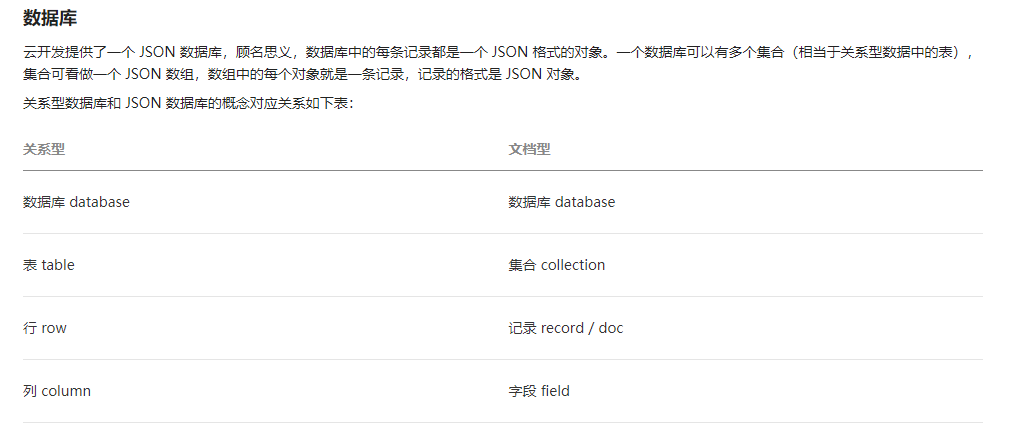
New database

New data
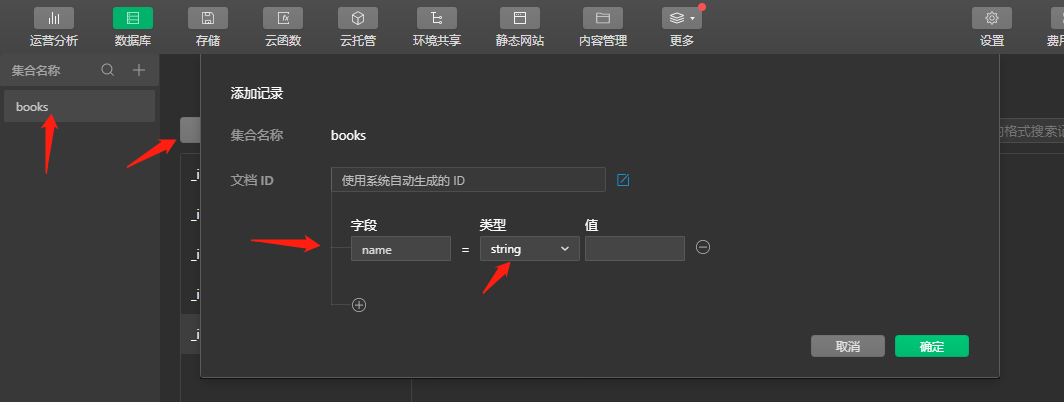

2-1. Query
1. Query all
index.js
const db = wx.cloud.database()
Page({
data: {
books:[]
},
onLoad (options) {
db.collection('books').get().then(res=>{
this.setData({
books:res.data
})
})
},
})
index.html
<!--index.wxml-->
<view class="container">
<view class="title">Database learning</view>
<view wx:for="{{books}}" wx:key='_id' class="book_item">
<image class="book_img" mode="widthFix" src="{{item.img}}"></image>
<view class="book_info">
<view>title:{{item.name}}</view>
<view>Author:{{item.author}}</view>
<view>Price:{{item.price}}</view>
</view>
</view>
</view>
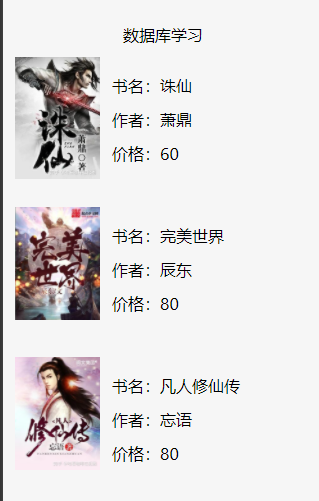
The where method can specify query criteria (query data with a price of 80)
db.collection('books').where({
price:80
}).get().then(res=>{
this.setData({
books:res.data
})
})
2. Query instructions: all instructions are exposed in dB On the command object
onLoad (options) {
const _ = db.command
db.collection('books').where({
// The gt method is used to specify a greater than condition, where gt(80) is a condition greater than 80
price: _.gt(80)
})
.get().then(res=>{
this.setData({
books:res.data
})
})
},
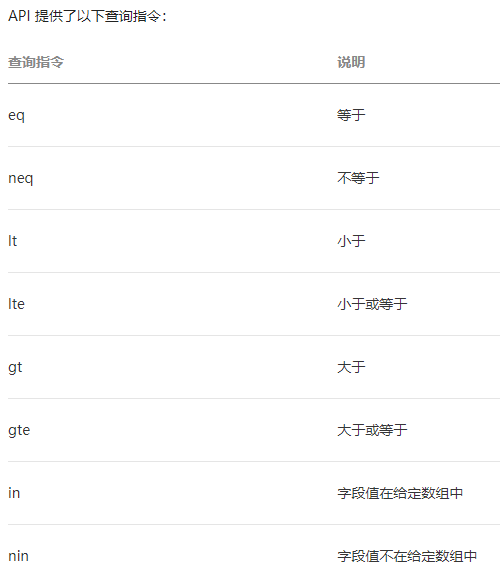
##3. Logical instructions and, or
const _ = db.command
db.collection('books').where({
and Method to specify a "And" Conditions, which means that they need to be met at the same time _.gt(30) and _.lt(80) Two conditions
//price: _.gt(30).and(_.lt(90))
// The or method is used to specify an or condition, which means that eq(0) or eq(90)
price: _.eq(60).or(_.eq(90))
})
.get().then(res=>{
this.setData({
books:res.data
})
})
},
2-2. Update
Local update
updateBook(){
db.collection('books').doc('8937eaa9611a05f604ef5b3065050162').update({
// Data passes in data that needs to be updated locally
data: {
// Indicates that the done field is set to true
price: 120
},
success: function(res) {
console.log(res,'to update')
this.getBooks()
}
})
}

Update failed: because the data was manually added on the cloud development console, there was no update_ openid field, carried by the data created by the applet method_ openid, which can be changed
In addition to updating the field with the specified value, the database API also provides a series of update instructions for performing more complex update operations. The update instructions can be passed through dB Command get:
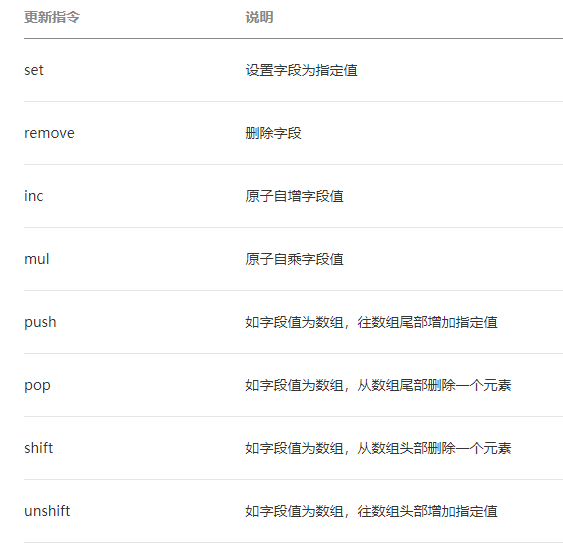
Example: add 10 to the price of the new data on the applet side
updateBook(){
const _ = db.command
db.collection('books').doc('8937eaa9611a18ac04f2a1480028048e').update({
// Data passes in data that needs to be updated locally
data: {
// Means to add 10 to the price
price:_.inc(10)
}
}).then(res=>{
console.log(res,'to update');
this.getBooks()
})
},

Replace update: if you need to replace and update a record, you can use the set method on the record. Replace update means to replace the specified record with the incoming object:
updateBook(){
db.collection('books').doc('8937eaa9611a18ac04f2a1480028048e').set({
// Data incoming data to be updated
data: {
price:150,
name:'A thought of eternity',
author:'Bai Xiaochun'
}
}).then(res=>{
console.log(res,'to update');
this.getBooks()
})
},

2-3. Add
<view>title:<input bindinput='addBookName' /></view> <view>Author:<input bindinput='addBookAuthor' /></view> <view>Price:<input bindinput='addBookPrice' /></view> <button type="primary" bindtap="addBook">newly added</button>
addBookName(e){
console.log(e.detail.value,'title');
this.setData({
bookName:e.detail.value
})
},
addBookAuthor(e){
this.setData({
bookAuthor:e.detail.value
})
},
addBookPrice(e){
this.setData({
bookPrice:e.detail.value
})
},
addBook(){
db.collection('books').add({
// The data field represents the JSON data to be added
data: {
name:this.data.bookName,
price:parseInt(this.data.bookPrice),
author:this.data.bookAuthor,
}
})
.then(res => {
console.log(res,'newly added')
})
}
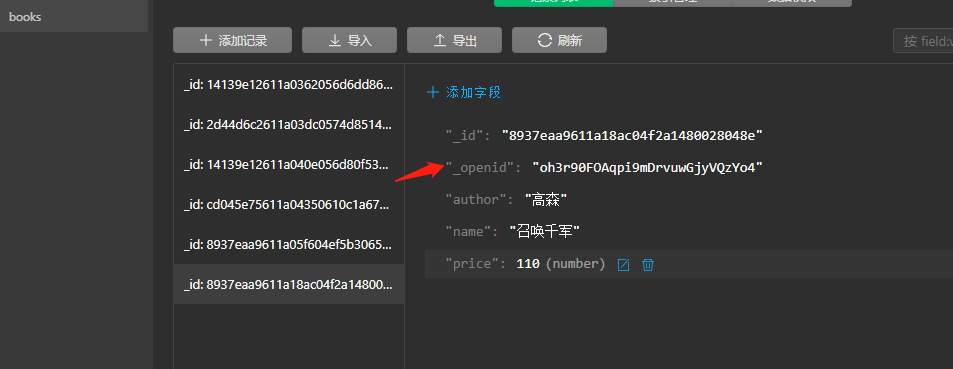
New data with_ openid, you can test and modify
<button type="primary" bindtap="updateBook">to update</button>
updateBook(){
db.collection('books').doc('8937eaa9611a18ac04f2a1480028048e').update({
// Data passes in data that needs to be updated locally
data: {
// Indicates that the done field is set to true
price: 120
}
}).then(res=>{
console.log(res,'to update');
this.getBooks()
})
},

2-4. Delete
Delete a record remove
Delete the data manually added on the cloud development console (no _openid)
deleteBook(){
db.collection('books').doc('14139e12611a040e056d80f5374d86d1').remove().then(res=>{
console.log(res,'delete');
this.getBooks()
})
},

Replace the data created on the applet side
deleteBook(){
db.collection('books').doc('8937eaa9611a18ac04f2a1480028048e').remove().then(res=>{
console.log(res,'delete');
this.getBooks()
})
},

Delete multiple records (you can select multiple records to delete through the where statement, and only the records with permission to delete will be deleted)
deleteBook(){
db.collection('books').where({
price: 150
}).remove().then(res=>{
console.log(res,'delete');
this.getBooks()
})
},

Directly operate the database, only one is deleted, and the cloud function can delete multiple
Complete example
const db = wx.cloud.database() //Get reference to database
const _ = db.command //Get database query and update instructions
db.collection("china") //Get the reference of the collection china
.where({ //Query condition instruction where
gdp: _.gt(3000) //Query filter criteria, gt indicates that the field must be greater than the specified value.
})
.field({ //What fields are displayed
_id:false, //Default display_ id, this is hidden
city: true,
province: true,
gdp:true
})
.orderBy('gdp', 'desc') //Sort by, descending
.skip(0) //How many records are skipped (commonly used for paging). 0 means that it is not skipped here
.limit(10) //Limit the number of records displayed, here is 10
.get() //Get the collection data filtered according to the query criteria
.then(res => {
console.log(res.data)
})
.catch(err => {
console.error(err)
})
3. Store
3-1. Upload files
Upload pictures
uploadFile(){
wx.chooseImage({
success (res) {
console.log(res)
const tempFilePaths = res.tempFilePaths;
wx.cloud.uploadFile({
cloudPath: 'example.png', // Path uploaded to the cloud
filePath: tempFilePaths[0], // Applet temporary file path
success: res => {
// Return file ID
console.log(res.fileID)
},
fail: console.error
})
}
})
}

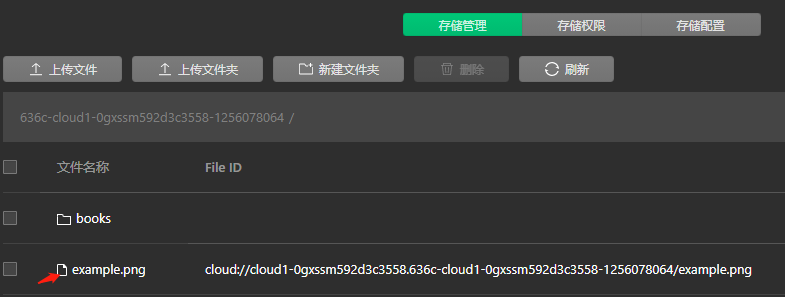
Upload the picture and display it (obtain the temporary path according to the file ID)
uploadFile(){
wx.chooseImage({
success: (res) =>{
const tempFilePaths = res.tempFilePaths;
wx.cloud.uploadFile({
cloudPath: 'example.png', // Path uploaded to the cloud
filePath: tempFilePaths[0], // Applet temporary file path
success: res => {
// Return file ID
wx.cloud.getTempFileURL({
fileList: [res.fileID],
success: res => {
// fileList is an array of objects with the following structure
// [{
// fileID: 'cloud://xxx.png ', / / file ID
// tempFileURL: '', / / temporary file network link
// maxAge: 120 * 60 * 1000, / / expiration date
// }]
console.log(res.fileList[0].tempFileURL)
this.setData({
imgUrl:res.fileList[0].tempFileURL
})
console.log(this.data.imgUrl)
},
fail: console.error
})
},
fail: console.error
})
}
})
}```
Upload video
```javascript
uploadFile(){
wx.chooseVideo({
sourceType: ['album','camera'],
maxDuration: 60,
camera: 'back',
success:(res)=> {
wx.showLoading({
title: 'Uploading',
})
console.log(res.tempFilePath)
wx.cloud.uploadFile({
cloudPath: 'video.mp4', // Path uploaded to the cloud
filePath: res.tempFilePath, // Applet temporary file path
success: res => {
// Return file ID
console.log(res.fileID)
wx.cloud.getTempFileURL({
fileList: [res.fileID],
success: res => {
// fileList is an array of objects with the following structure
// [{
// fileID: 'cloud://xxx.png ', / / file ID
// tempFileURL: '', / / temporary file network link
// maxAge: 120 * 60 * 1000, / / expiration date
// }]
console.log(res.fileList)
this.setData({
videoSrc:res.fileList[0].tempFileURL
})
wx.hideLoading()
},
fail: console.error
})
},
fail: console.error
})
}
})
}
Upload file
uploadFile(){
wx.chooseMessageFile({
count: 1,
type: 'file',
success: (res)=> {
// tempFilePath can display pictures as src attribute of img tag
const tempFilePaths = res.tempFiles
console.log(tempFilePaths,'Return path')
wx.cloud.uploadFile({
cloudPath: 'example.pdf', // Path uploaded to the cloud
filePath: tempFilePaths[0].path, // Applet temporary file path
success: res => {
// Return file ID
console.log(res.fileID)
},
fail: console.error
})
}
})
},
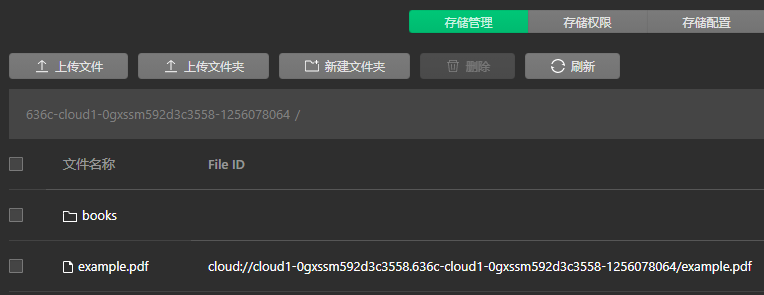
Download pictures
downloadFile(){
wx.cloud.downloadFile({
fileID: 'cloud://cloud1-0gxssm592d3c3558.636c-cloud1-0gxssm592d3c3558-1256078064/example.png ', / / file ID
success: res => {
// Return temporary file path
console.log(res.tempFilePath,'download')
wx.saveImageToPhotosAlbum({
filePath:res.tempFilePath,
success:(res)=> {
console.log(res,'preservation')
}
})
},
fail: console.error
})
}

Download the file and open it
downloadFile(){
wx.cloud.downloadFile({
fileID: 'cloud://cloud1-0gxssm592d3c3558.636c-cloud1-0gxssm592d3c3558-1256078064/example.pdf ', / / file ID
success: res => {
// Return temporary file path
console.log(res.tempFilePath,'download')
wx.openDocument({
filePath: res.tempFilePath,
success: (res)=> {
console.log('The document was opened successfully')
}
})
},
fail: console.error
})
},

Delete file
deleteFile(){
wx.cloud.deleteFile({
fileList: ['cloud://cloud1-0gxssm592d3c3558.636c-cloud1-0gxssm592d3c3558-1256078064/example.png'],
success: res => {
// handle success
console.log(res.fileList)
},
fail: console.error
})
}

4. Cloud function
4-1. Create a new cloud function
Right click the cloud function root directory, and in the right-click menu, you can select Create a new node JS cloud function add
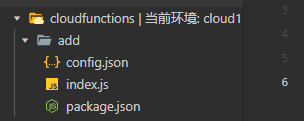
add. JS (cloud function)
// Cloud function entry file
const cloud = require('wx-server-sdk')
cloud.init({
env:'cloud1-0gxssm592d3c3558'
})
// Cloud function entry function
exports.main = async (event, context) => {
return event.a + event.b
}
Calling cloud function in page js
// pages/cloundfn/cloundfn.js
Page({
data:{
sum:0,
},
onLoad(options) {
wx.cloud.callFunction({
// Cloud function name
name: 'add',
// Parameters passed to the cloud function
data: {
a: 1,
b: 2,
},
})
.then(res => {
console.log(res.result) // 3
this.setData({
sum:res.result
})
})
.catch(console.error)
},
})
Right click the cloud function and click upload and deploy (cloud installation depends on node_modules, which are not uploaded)
Then you can see the uploaded cloud functions on the cloud development console

Click local test to pop up the cloud function local test pop-up box. Click the right to open the local test and install node_modules dependency. Recompile the page code to see the return value
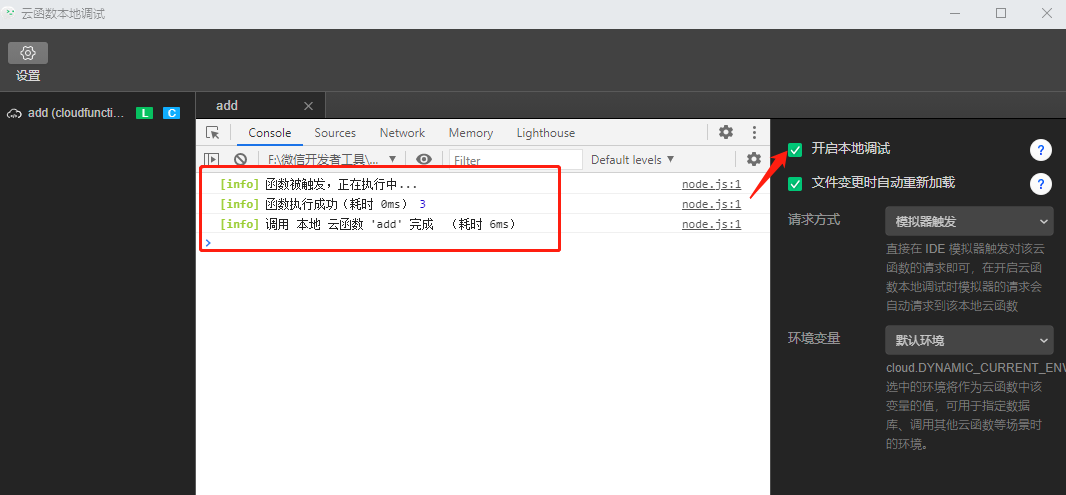
Show returned results

4-2. Obtain applet user information through cloud function
<button type="primary" bindtap="getUserInfo">Get user information</button>
getUserInfo(){
wx.cloud.callFunction({
// Cloud function name
name: 'getOpenId',
})
.then(res => {
console.log(res,'User information') //
this.setData({
openId:res.result.OPENID,
appId:res.result.APPID,
})
})
.catch(console.error)
}
Create a new getOpenId cloud function, right-click to upload and deploy

Local test

Debugger return
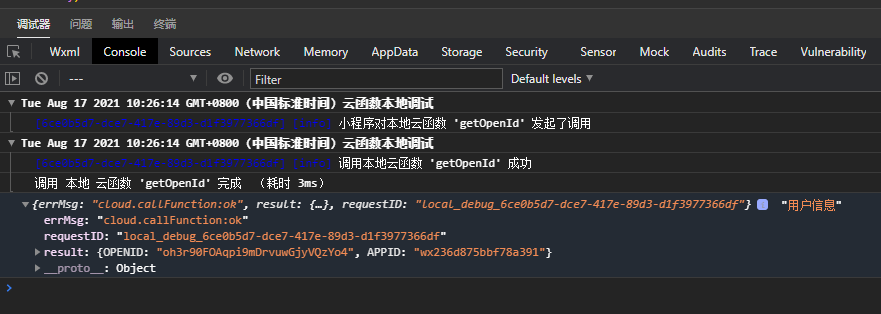
Page display
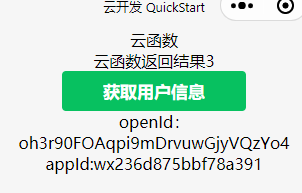
4-3. Cloud function call database
1. Cloud function to get the list of books
Get data from page js
onLoad (options) {
this.getBooks()
},
getBooks(){
wx.cloud.callFunction({
// Cloud function name
name: 'getBooks',
})
.then(res => {
console.log(res,'Book information') //
this.setData({
books:res.result.data
})
})
.catch(console.error)
},
Create a new getBooks cloud function, upload and deploy it
const cloud = require('wx-server-sdk')
cloud.init({
env: cloud.DYNAMIC_CURRENT_ENV
})
const db = cloud.database()
exports.main = async (event, context) => {
// The get method on the collection will return a Promise, so the cloud function will return the result after the database asynchronously fetches the data
return db.collection('books').get()
}

Local debugging

Debugger output
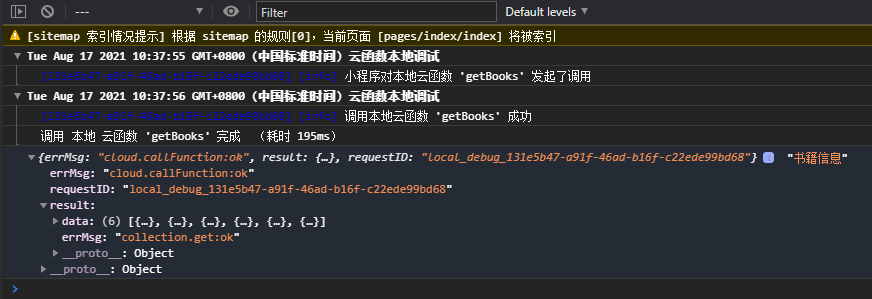
2. New books on cloud functions
Page js method
addBook(){
wx.cloud.callFunction({
// Cloud function name
name: 'addBook',
data:{
name:this.data.bookName,
price:parseInt(this.data.bookPrice),
author:this.data.bookAuthor,
}
})
.then(res => {
console.log(res,'New book information') //
})
.catch(console.error)
}
New book cloud function
// Cloud function entry file
const cloud = require('wx-server-sdk')
cloud.init({
env: cloud.DYNAMIC_CURRENT_ENV
})
const db = cloud.database()
// Cloud function entry function
exports.main = async (event, context) => {
const {name,price,author} = event
console.log(name,price,author,'Transmitted data')
return db.collection('books').add({
// The data field represents the JSON data to be added
data: {
name,
price,
author,
}
})
.then(res => {
console.log(res,'newly added')
})
}
be careful
cloud.init({
env: cloud.DYNAMIC_CURRENT_ENV
})
To be in
const db = cloud.database()
Initialize before, otherwise an error will be reported
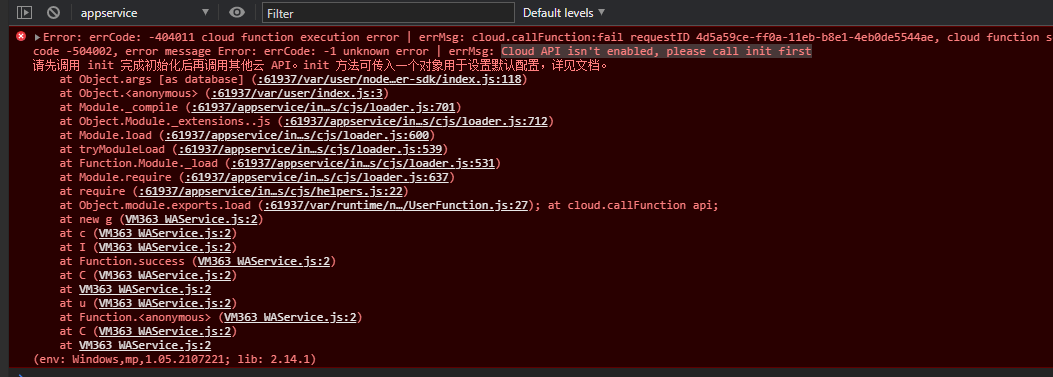
result:
Cloud function local debugging pop-up
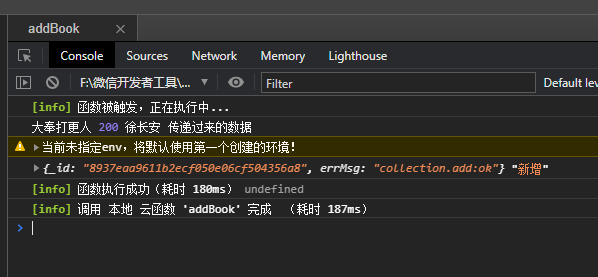
Debugger:

3. Cloud function delete books
Create a new cloud function for deleteBooks
// Cloud function entry file
const cloud = require('wx-server-sdk')
cloud.init({
env: cloud.DYNAMIC_CURRENT_ENV
})
const db = cloud.database()
// Cloud function entry function
exports.main = async (event, context) => {
//Delete data with price of 150
return db.collection('books').where({
price: 150
}).remove()
.then(res => {
console.log(res,'delete')
})
}
Page method call:
deleteBook(){
wx.cloud.callFunction({
// Cloud function name
name: 'deleteBooks',
})
.then(res => {
console.log(res,'information') //
})
.catch(console.error)
},
Cloud function local debugging return
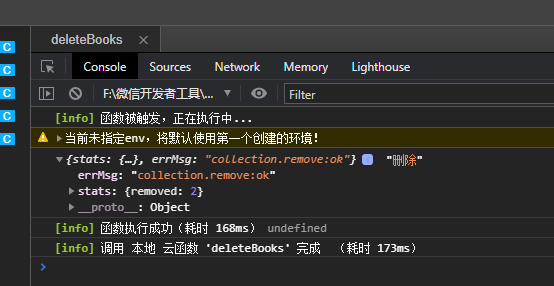
Debugger return
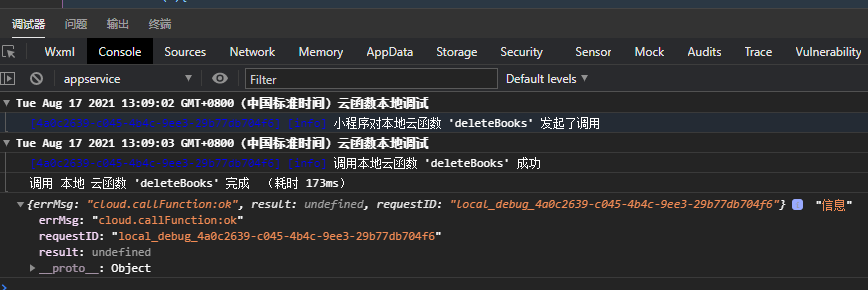
4. Call storage in cloud function
Suppose we want to upload a picture file (demo.jpg) contained in the cloud function Directory:
const cloud = require('wx-server-sdk')
const fs = require('fs')
const path = require('path')
cloud.init({
env: cloud.DYNAMIC_CURRENT_ENV
})
exports.main = async (event, context) => {
const fileStream = fs.createReadStream(path.join(__dirname, 'demo.jpg'))
return await cloud.uploadFile({
cloudPath: 'demo.jpg',
fileContent: fileStream,
})
}
In the cloud function__ The value of dirname is the directory where the cloud function code is located
5. Calling other cloud functions in cloud function "
const cloud = require('wx-server-sdk')
cloud.init({
env: cloud.DYNAMIC_CURRENT_ENV
})
exports.main = async (event, context) => {
return await cloud.callFunction({
name: 'sum',
data: {
x: 1,
y: 2,
}
})
}